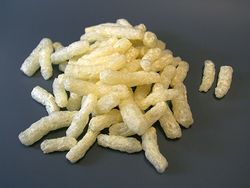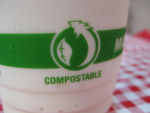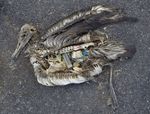Biodegradable plastic
Plastics present a major problem in our world today. The demand for them is becoming larger, as well as the negative impact they have on the environment. A solution for these problems may lie in the recent development of bioplastics, also known as biodegradable plastics. These amazing products can be used for nearly every use that exists for conventional plastic, without the adverse effects on the environment. Mostly composed of plant fibers, these plastics can be broken down completely into the organic components they are manufactured from in the proper composting facilities. In addition to this, it takes a fraction of the time to decompose.
Biodegradability
Biodegradable plastics can be separated into two categories based on the process by which they break down: oxo-biodegradable and hydro-biodegradable. As the names suggest, these are chemical processes (oxidation and hydrolysis). Both of these produce CO2 as they break down, and hydro-biodegradable produces methane as well.
In oxo-biodegradable plastics, an additive is added in the plastic that encourages it to break down. This additive changes the molecular structure of the plastic which allows it to be broken down and consumed further by bacteria and other microorganisms. After this process, the biodegradable plastic has been completely reduced to CO2, water, and humus. [1] Oxo-biodegradable plastics are sometimes called 'degradable' plastic since they do not necessarily need the help of the microorganisms to break down (they simply speed the process up), but they can break down purely by exposure to sunlight and heat. This process of degradation can happen in as little as twelve months; however, it lasts for long periods of time when it is stored in the proper environment. Hydro-biodegradable plastics are usually starch-based and break down with moisture.[2]
Composition
Biodegradable plastics can be made from many different materials. Some of these include plant materials such as orange peels, corn oil, plant starches and other natural materials such as starch from tapioca, potatoes, cellulose, soy protein, and lactic acid. Polylactic acid or (PLA), is the main ingredient of plastics made from corn-based materials. It is made by a fermentation process, in which workers mill large amounts of corn kernels to remove the dextrose which is then made into lactic acid (which is a by-product of fermentation). The lactic acid is converted into lactide and then, manufacturers then move on to create long chains, or link the lactide to polymers to make PLA. [3]
Uses
Biodegradable plastic has many current and potential uses. A few of these potential uses include medical applications. One of these is biodegradable plastics serving as an implant that would not require a second surgery to remove. If a biodegradable implant was used instead of a stainless steel alternative especially for bones, the rigid stress that the steel has on the bone would be eliminated. Researchers and biochemists hope to engineer the plastic to degrade at a rate that allows the load to slowly be transferred to the bone. [4]
Biodegradable plastics can be used for any application that conventional plastics are currently fulfilling. This includes, plastic bags, water bottles, produce containers, plastic sheeting, utensils, such as disposable forks and spoons, and many more. Another application for bioplastics is as cosmetic containers. These products stored in the plastic containers do not last very long and much of the 120 million units of packaging ends up in the landfills. Replacing these with biodegradable plastic would prevent substantial amounts of plastic from ending up in the landfill. Using bioplastics in the automotive industry has also become a novel idea. This is due to enormous amount of petroleum-based plastic materials that go into the manufacturing of vehicles. [5]
Pros and Cons
Common plastics that people come into contact with everyday are most likely petroleum-based plastics. These plastics break down through the sun's UV rays, a process called photodegradation. However, they do not break down completely, but into smaller toxic pieces that animals, and later, humans ingest. This is a major problem that mankind encounters. The demand for plastic is quite enormous, but these products can be significantly detrimental to the environment. A solution to this problem lies in biodegradable polymers. One beneficial aspect to using biodegradable plastics is that it could cut down on the amount of oil that is used. By replacing approximately 114 million plastic produce containers per year with a bioplastic alternative such as PLA, 800,000 barrels of oil could be conserved. PLA is also carbon neutral so it burns clean and does not release any additional pollutants into the environment.
One downfall of bioplastics is that they normally degrade relatively slowly unless they are subjected to a industrial process. In this "controlled composting environment," PLA will break down faster. It takes a much longer time it the plastic is in a compost bin or other similar environments. Another con of the biodegradable plastic PLA is the fact that it cannot be mixed with any other kind of plastic. This is due to the fact that these other plastics require a recycling facility while the bioplastic needs a composting facility. In addition to this, only 113 composting facilities exist in the U.S. alone. Also, the production of bioplastics from plant starch (mostly corn) comes from genetically modified varieties. This raises other controversial issues relating to the detrimental effects that it may have on the environment. [6]
Video
Video briefly explaining the importance and usefulness of biodegradable plastic and where it is from.
References
- ↑ . Biodegradable Plastics Atlantic Poly Inc.. Web. last accessed 20 April 2015. Author unknown.
- ↑ . All about oxo-biodegradable plastic bags. Noteworthy.com. Web. last accessed 20 April 2015. author unknown.
- ↑ Royte, Elizabeth. Corn Plastic to the Rescue Smithsonian.com. Web. published August 2006.
- ↑ . Biodegradable polymers in medical applications Plastemart.com. Web. last accessed 4 May 2015. Author unknown.
- ↑ . applications Biome Bioplastics.com. Web. last accessed 5 May 2015. author unknown.
- ↑ . Pros and Cons of the Corn-based Plastic PLA About.com. Web. last accessed 4 May 2015. Author unknown.
| ||||||||||||||




